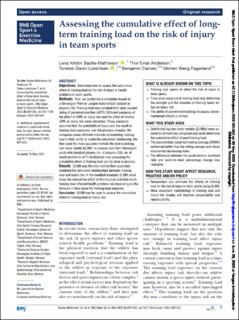Assessing the cumulative effect of long-term training load on the risk of injury in team sports
Bache-Mathiesen, Lena Kristin; Andersen, Thor Einar; Dalen-Lorentsen, Torstein; Clarsen, Benjamin Matthew; Fagerland, Morten
Peer reviewed, Journal article
Published version
Permanent lenke
https://hdl.handle.net/11250/3009081Utgivelsesdato
2022Metadata
Vis full innførselSamlinger
- Artikler [5061]
- Publikasjoner fra CRIStin FHI [7536]
Sammendrag
Objectives: Determine how to assess the cumulative effect of training load on the risk of injury or health problems in team sports. Methods: First, we performed a simulation based on a Norwegian Premier League male football dataset (n players=36). Training load was sampled from daily session rating of perceived exertion (sRPE). Different scenarios of the effect of sRPE on injury risk and the effect of relative sRPE on injury risk were simulated. These scenarios assumed that the probability of injury was the result of training load exposures over the previous 4 weeks. We compared seven different methods of modelling training load in their ability to model the simulated relationship. We then used the most accurate method, the distributed lag non-linear model (DLNM), to analyse data from Norwegian youth elite handball players (no. of players=205, no. of health problems=471) to illustrate how assessing the cumulative effect of training load can be done in practice. Results: DLNM was the only method that accurately modelled the simulated relationships between training load and injury risk. In the handball example, DLNM could show the cumulative effect of training load and how much training load affected health problem risk depending on the distance in time since the training load exposure. Conclusion: DLNM can be used to assess the cumulative effect of training load on injury risk. Assessing the cumulative effect of long-term training load on the risk of injury in team sports
